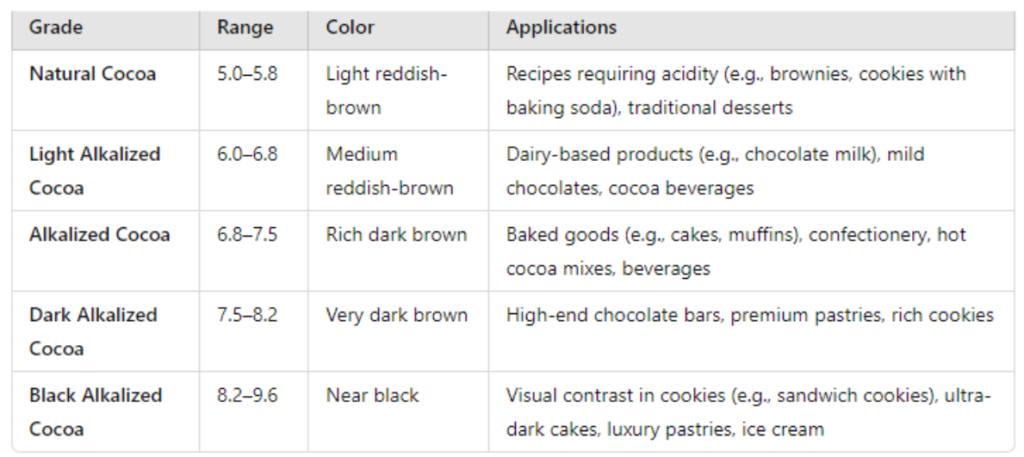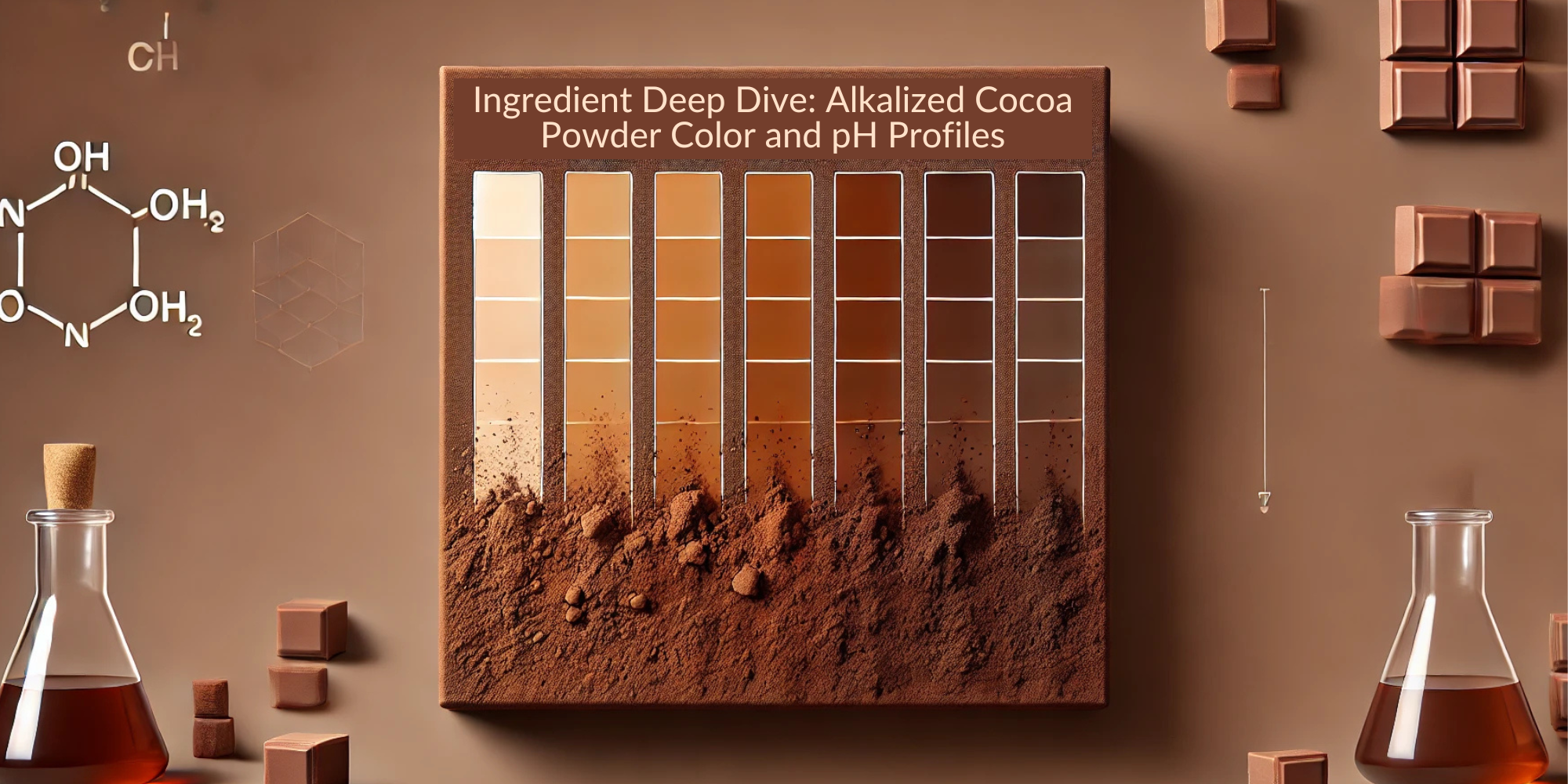Alkalization is a key process in the transformation of cocoa powder, modifying its pH and color significantly.
The resulting changes influence everything from taste to solubility and color, which is critical in applications ranging from baking to beverages.
In this blog, we will delve into the color and pH profiles of alkalized cocoa powder, examining the full spectrum of shades from light reddish hues to deep black, and explore the effect of pH levels from natural cocoa to black cocoa (pH 9.6).
The Alkalization Process and Its Impact on pH
Alkalization, or Dutch processing, involves treating cocoa beans, nibs, or cocoa liquor with an alkali to neutralize its acidity.
The degree of alkalization determines the pH level, which in turn influences the cocoa’s flavor, texture, solubility, and interaction with other ingredients.
Below are the common pH ranges observed in cocoa powders at different stages of alkalization:
1. Natural Cocoa (pH 5.0–5.8)
- pH Profile: Natural cocoa powder has the lowest pH, ranging between 5.0 to 5.8, making it more acidic than alkalized variants. This acidity imparts a sharp, fruity flavor characteristic of natural cocoa beans.
- Applications: Ideal for recipes requiring acidity, such as those using baking soda, where the acidic cocoa helps with leavening and flavor.
2. Light Alkalized Cocoa (pH 6.0–6.8)
- pH Profile: With minimal alkalization, the pH slightly rises above neutral, producing a smooth, less acidic flavor.
- Applications: Preferred in dairy-based products like hot chocolates, milk beverages, and light chocolates where acidity can be subdued.
3. Alkalized Cocoa (pH 6.8–7.5)
- pH Profile: Moderately alkalized cocoa, often called “standard alkalized,” has a pH approaching neutral, making it versatile for most applications.
- Applications: Used widely in bakery items, dark chocolates, and confectionery where a balance of flavor and color is desired.
4. Dark Alkalized Cocoa (pH 7.5–8.2)
- pH Profile: The significant alkalization gives the cocoa a higher pH, deepening the color and reducing bitterness.
- Applications: Suitable for baked goods, cookies, and high-end chocolates requiring rich, dark tones.
5. Black Alkalized Cocoa (pH 8.2–9.6)
- pH Profile: The most heavily alkalized cocoa powder has a pH up to 9.6, imparting a nearly black color and a neutral, mild flavor.
- Applications: Primarily used for visual impact in dark cookies (such as sandwich cookies), ice cream, and coatings.

The Color Spectrum of Alkalized Cocoa
The color of cocoa powder evolves as the degree of alkalization increases, transitioning from light reddish-brown tones to nearly black.
This change in color is due to the chemical interaction of the cocoa with the alkali. The intensity of the color is often directly linked to the extent of alkalization.
1. Natural Cocoa (Light Reddish-Brown)
- Color: Natural cocoa retains a light reddish-brown hue with a slight reddish tint, owing to its unprocessed state.
- Applications: Ideal for traditional chocolates and baking where a more rustic, natural appearance is desirable.
2. Light Alkalized Cocoa (Reddish-Brown)
- Color: With a small increase in pH, light alkalized cocoa begins to lose its red undertones and transitions to a medium reddish-brown color.
- Applications: Frequently used in dairy-based products like chocolate milk or lighter chocolate desserts where the reddish-brown color complements the product’s visual appeal.
3. Medium Alkalized Cocoa (Dark Brown)
- Color: As alkalization progresses, the reddish hues fade, and the cocoa becomes a rich dark brown. This is one of the most commonly used grades in commercial applications.
- Applications: Suitable for a wide range of uses, including bakery, dark chocolates, and confectionery, where rich flavor and a deep brown color are essential.
4. Dark Alkalized Cocoa (Very Dark Brown)
- Color: With increased alkalization, the color becomes very dark brown, almost black but not fully. This is typical of premium chocolates and luxury baked goods.
- Applications: Used in high-end pastries, dark chocolate bars, and brownies, where a robust, dark color adds to the indulgence factor.
5. Black Alkalized Cocoa (Near Black)
- Color: Black alkalized cocoa is the darkest grade, with a color close to pure black. This intense hue is achieved through heavy alkalization and is mostly used for its striking visual impact.
- Applications: Commonly found in applications requiring a dramatic visual effect, such as sandwich cookies, ultra-dark cakes, and ice creams.

The Relationship Between Color and pH in Alkalized Cocoa
The transformation of cocoa’s color during alkalization is closely linked to changes in its pH. As the pH increases, the color becomes progressively darker.
This is due to the breakdown of anthocyanins, natural pigments in cocoa beans, which change in color intensity as alkalinity rises.
The higher the pH, the more intense the darkening effect, shifting from light reddish-brown to nearly black.
Effects of pH on Applications
The pH of cocoa powder influences its interactions with other ingredients, making it an important consideration in different product formulations.

1. Beverages
- Effect: Higher pH cocoas (dark and black alkalized) dissolve more easily in liquid, making them ideal for instant drinks and chocolate milk.
- Application: Light alkalized or natural cocoa, being more acidic, may require more mixing and contribute a sharper flavor to hot chocolate or cocoa beverages.
2. Baking
- Effect: Natural cocoa (acidic) reacts with baking soda to produce lift, while alkalized cocoa (neutral or alkaline) works best with baking powder.
- Application: Alkalized cocoa offers smoother flavors and is used in cakes, brownies, and cookies where acid-driven leavening is not required.

3. Confectionery and Dairy
- Effect: High-pH cocoas tend to have better solubility and neutral flavors, making them ideal for dairy-based products and chocolate coatings.
- Application: Alkalized cocoa integrates seamlessly into ice creams, chocolate sauces, and syrups.
Effects of Color on Applications
In many food applications, color is as important as flavor. The color of cocoa powder impacts consumer perception and the overall visual appeal of the product.
1. Light Reddish-Brown (Natural Cocoa)
- Effect: The lighter reddish-brown tones of natural cocoa work well in traditional desserts where a rustic, homemade feel is desirable.
- Application: Used in cakes, muffins, and handcrafted chocolates.
2. Medium to Dark Brown (Light and Alkalized Cocoa)
- Effect: These shades are preferred in dairy products, ice creams, and chocolates where the deep brown conveys richness and quality.
- Application: Perfect for premium chocolates and visually appealing bakery items.
3. Very Dark Brown to Black (Dark and Black Alkalized Cocoa)
- Effect: These deep, dark tones add a luxurious feel to the product. Black cocoa, especially, is used in products where the color is meant to stand out, such as in sandwich cookies and dark pastries.
- Application: Often used in high-end pastry and cookie applications where color contrast is key.

Conclusion
Understanding the pH and color profiles of alkalized cocoa powder is essential for food technologists and product developers.
The interplay between alkalization, pH, and color affects not only the flavor and texture but also the visual appeal of the final product.
By choosing the right grade of cocoa—whether natural, light alkalized, or heavily alkalized—manufacturers can tailor their products to specific functional and aesthetic needs, ensuring consistent quality and consumer satisfaction.








